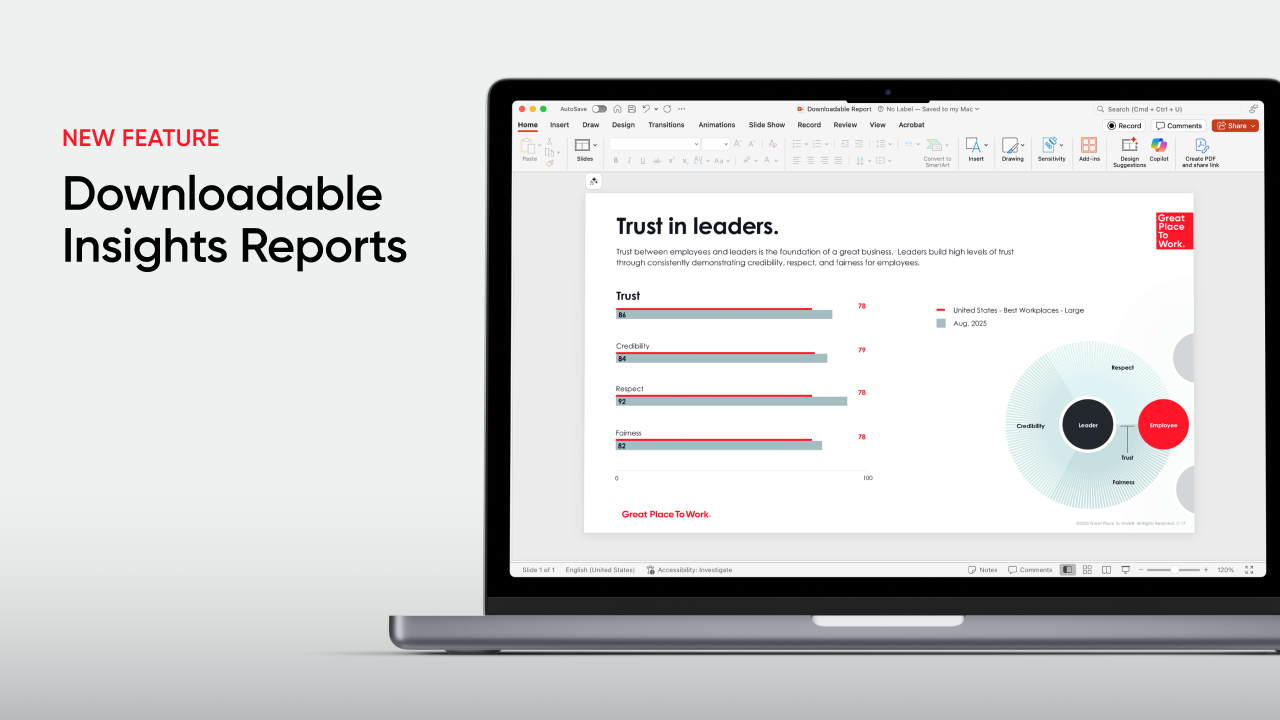Employee Experience, Employee Recognition, Employee Surveys
Building a great workplace for all isn’t a solo endeavor. By creating space for employees to voice their thoughts and put forward ideas, you foster a culture of open communication that drives engagement, innovation, and trust.
What makes an organization a great workplace for all? Through our research, we know it’s one defined, in short, by a shared sense of trust, pride, and camaraderie among employees.
One way leaders build a workplace culture where every employee can experience this is simple: give your people a voice.
As the workplace has rapidly evolved over the past five years, it isn’t surprising that “employee voice” has entered the conversation. With organizations embracing remote and hybrid work and a flattened hierarchical structure, it’s critical that leaders create space to listen to employees.
As Michael C. Bush, CEO of Great Place To Work®, says, “Employees want to be heard, valued, and cared for.”
Employee voice is a powerful way to tap into your greatest resource — your people — to increase employee satisfaction, drive innovation, and productivity.
What is employee voice and why does it matter?
Employee voice, also known as “voice of the employee” (VoE), means employees have the ability to share their thoughts, ideas, or concerns within an organization without fear of negative consequences.
Giving employees a voice is the cornerstone of building a positive work culture, one where different perspectives are welcomed. When employees have a safe space to share insights, they can put forward creative ideas, suggest improvements, or provide valuable insights on issues leaders may not be aware of.
The benefits of strong employee voice
Employee voice helps organizations move away from a top-down culture to one of collaboration and open communication. The benefits to leaders, organizations, and their people speak for themselves:
- Trust: When employees feel safe enough to speak up, it builds trust between people and leadership. Trust is integral to the Great Place To Work Model and an indicator of a healthy workplace culture. High-trust workplaces are more resilient and see better stock market success.
- Engagement: When leadership creates spaces for employees to give honest feedback, they’re more likely to be engaged, and employee satisfaction increases. Improved team morale means employees can engage with new ideas, share knowledge, and support teammates.
- Productivity: When employees feel heard, they are more motivated and committed to their work. This sense of validation not only boosts morale but also encourages individuals to contribute their best efforts, leading to higher productivity, driving strong business results.
- At the Fortune 100 Best Companies to Work For®, where an “always listening” culture is prioritized, the willingness to give extra at work is 70% higher compared to a typical U.S. workplace.
- Retention: Research shows that at any given time, on average, more than half of your workforce is considering new opportunities. Replacing talent costs time and money. However, giving employees a voice is a powerful retention strategy. It amplifies the message that your people are vital for the company’s success.
- Inclusivity: In any diverse organization, creating a workplace for all is critical for success. Tapping into the voice of all employees not only maximizes the potential of every person, it also helps create a more inclusive environment — which leads to greater innovation, employee retention and higher revenue growth.
Strategies for encouraging employee voice
Some people may feel anxious or hesitate to exercise their employee voice and share concerns or opinions. Here’s the role leaders can take in creating an environment where everyone feels encouraged to speak up:
-
Create a safe environment: A safe environment is one of trust, open communication, and mutual respect. Reassure confidentiality, such as with survey confidentiality, or other channels, and encourage honest feedback to create psychological safety.
For example, Ryan LLC fosters psychological safety by encouraging risk-taking and celebrating mistakes.
Leaders at Ryan model vulnerability by openly sharing their own mistakes and learning experiences, which sets the tone for a culture where trying and failing is seen as a natural part of growth.
This approach helps employees feel safe to take risks and share their ideas without fear of negative repercussions. By recognizing and rewarding efforts, even when they don’t lead to success, Ryan reinforces the message that the organization values growth and development, building trust and encouraging employees to continue voicing their thoughts. -
Active listening: When employees feel heard, they feel valued. Stay calm and set aside assumptions when employees are talking. Pay attention to both the explicit and implicit things people are saying and acknowledge their concerns.
-
Recognition: Show appreciation when employees voice concerns or make contributions. Show that their input is taken seriously and provide feedback on any next steps being taken.
For example, The Breakers Palm Beach uses an employee opinion survey (EOS) stamp to visibly acknowledge that certain changes or programs were products of employee feedback. This stamp, which reads “Product of EOS employee opinion survey,” is a powerful tool that validates employees’ contributions and fosters a sense of ownership and pride in the workplace.
By seeing their feedback lead to tangible outcomes, employees feel appreciated and recognized. This boosts morale and encourages ongoing participation in feedback mechanisms. -
Provide multiple channels for feedback: Give employees more than one way to voice their thoughts. Use a variety of feedback mechanisms, such as employee surveys, employee resource groups, skip-meetings, or one-on-one conversations.
For example, Wegmans Food Markets has implemented several employee voice channels to ensure their frontline workers feel heard and valued.One notable example is the “Ask Jack” initiative, where employees can submit suggestions and questions directly to Jack DePeters, the company’s SVP of operations.
Since its launch in 2002, Jack has responded to over 16,000 employee comments, with 68% of employees choosing to identify themselves by name rather than submit anonymously.
The role of leadership in fostering employee voice
Leaders affect 70% of the employee experience, which is why leaders must model open communication and create a high-trust environment where employees are comfortable sharing their concerns.
An inclusive culture requires transparency, accountability, and vulnerability.
Create a space in meetings and interactions by letting people know their input is welcome. Put opinions aside and give attention to people’s thoughts and experiences from a place of humility and empathy.
When leaders demonstrate a high level of care, it creates a safe space for others to share their opinions, in turn unlocking employee performance.
How to measure and analyze employee voice
To effectively measure and analyze employee voice, organizations should take a multifaceted approach that is both qualitative and quantitative:
Employee surveys: If you aren’t gathering feedback at least once a year, you might fail to notice changes in your employees’ experience. Employee surveys are an opportunity for employees to give honest feedback.
Our Trust Index™ Survey protects employees’ voices as the data is encrypted and de-identified. The result: reliable feedback you can act on and the opportunity for your people to speak honestly, knowing their voices won’t be singled out.
Employee resource groups: ERGs create a safe place for employees to come together and feel comfortable sharing their experience. Use the insights from ERGs to surface employee perspectives and understand the unique experience of specific groups within your organization.
Town Halls or Ask Me Anything (AMA) sessions: Town Halls and AMAs can be a powerful vehicle to give employees a voice and raise concerns directly with senior leaders. Synchrony’s listening practice includes “ask us anything” meetings with senior leadership. The sessions are open to 20,000 employees, as leaders answer questions on a variety of topics until there are no more questions from the audience.
One-on-one meetings: Establish regular, informal check-ins with employees to invite individual feedback and address any concerns.
Once organizations have garnered feedback, here are some suggestions on how to analyze employee feedback:
Review data: Review results at a high level. Look at data across demographics or employee groups to identify disparities in employee experience. Take a more granular look at the data to get a clear picture of what employees are saying.
Reflect on feedback: Surveying employee voice can provide invaluable insights into leadership and company culture. Reflect on feedback before responding or creating action plans. Ask questions such as:
- Which feedback is the most surprising?
- What steps can we take to show we are truly listening?
- Which feedback feels most difficult to address?
- What barriers might be preventing action, and how can we overcome them
- What strengths are emerging from the feedback? How can we amplify these to reinforce a positive workplace culture?
Identify improvements and develop plans: Identify and prioritize one or two areas for improvement, rather than tackling everything at once. Define attainable goals, communicate your commitment clearly, assign accountability partners across the organization, and establish a timeline for success.
Take action: Employee voice falls flat if leaders don’t commit to action. Develop a strategic, data-driven action plan. Be transparent and keep employees updated on the process.
Measure and review: Commit to continuous improvement and make adjustments as needed. Gather ongoing feedback from employees to gauge what is working and what additional ideas they would recommend.
How to overcome challenges in implementing employee voice initiatives
Introducing new initiatives, even something as beneficial as encouraging employee voice, can present challenges for organizations.
One of the most common obstacles leaders face is employee silence and fear of speaking up. Earlier, we defined employee voice as being able to share their thoughts without fear of negative consequences.
This part of the definition is key.
To overcome employees’ fear of speaking up, leaders need to cultivate psychological safety in the workplace. As Julian Lute, senior manager and strategic advisor with Great Place To Work, says, “When people feel psychologically safe in the organization — are able to share ideas, questions, concerns — the company is more agile.”
Here are some ways leaders can overcome resistance and foster a company culture of open communication:
- Create a safe space by reassuring confidentiality and encouraging honest feedback without fear of retribution.
- Be willing to be vulnerable, which will open the door for employees to feel comfortable raising concerns or offering suggestions.
- Make communication open, honest, and credible. Communicate consistently and make sure your actions match your words.
- Rather than leading top-down, be curious. Ask questions and be open to hearing the ideas of employees. Acknowledge any uncertainties and foster a company culture of problem-solving.
- The Best Workplaces™ commit to acting on feedback in a way that builds trust. Communicate regularly so employees understand how their feedback helps drive meaningful action.
Case studies: Successful employee voice programs
How listening to their people helped Brains increase its purpose and employee pride
As a B Corporation, commitment to sustainability and environmental care ranks high for Brains. However, only 72% of its people felt good about the company’s contribution to the community.
The challenge for the creative agency was to redefine what community meant for its employees. The Trust Index Survey was an opportunity for their employees to voice that they valued contribution to charitable organizations more than receiving a personal gift.
The solution? Brains transitioned from individual birthday gifts to increasing their overall donations to not-for-profits as a company. Not only were those donations making a positive impact, but employee pride in working for the company increased by 13 points.
Moe Rice, director of people and culture, describes the agency’s partnership with Great Place To Work as “a game changer for our culture and our work.”
How ECI Software Solutions listened to new employees and revitalized its onboarding program
When you go to work at a global tech company, you would expect onboarding to be smooth.
However, that wasn’t the case at ECI Software Solutions. Between 60% to 70% of people voiced that they had an inconsistent onboarding experience.
The software company didn’t wait to act. They surveyed new hires about their experience to get a clear picture of what was going wrong: missing laptops, insufficient access to systems, a lack of communication from managers, and other missteps.
“The first surveys were brutal,” says Andrew Prior, CHRO at ECI. Now, Prior reads onboarding surveys each week, and if something happens to go wrong, leaders immediately act to rectify the issue.
The result of listening to new hires has been unmistakable: More than 90% of the time, employees have the equipment and access they need on their first day — setting them up for success.
The future of employee voice in the workplace
As more companies move to hybrid and remote work, organizations don’t just need to reimagine the office, but also how to build a more equitable workplace where everyone has a say.
Fortunately, digital platforms make it easier for leaders to solicit feedback. Tools like virtual town halls and messaging apps like Slack mean employees can share their thoughts regardless of whether they work remotely or onsite.
Advances in AI will also revolutionize the future of employee voice through predictive analytics and data-driven insights. Soon, tools like virtual reality (VR) could also be used to collaborate, solicit feedback, and create an immersive sense of community.
Great Place To Work is also ensuring leaders have the data they need to succeed with Manager Access in the Trust Index Survey. Leaders can receive real-time insights into their teams’ experience to pinpoint areas of improvement, implement changes, and then track progress over time.
As workplaces and technology evolve, the role of employee voice in shaping organizational culture and driving business success remains constant.
Maximize your employee voice strategy
Employee feedback is a powerful tool to drive engagement, innovation, and trust in an organization. By creating a safe space to speak up, soliciting feedback from various channels, and taking meaningful action, employees can see how their voice matters.
Great Place To Work’s employee engagement software is a valuable tool for organizations looking to enhance their employee voice initiatives. Employee surveys are inclusive of all lines of business and deliver detailed, reliable data so you can unlock meaningful insights into your employee experience.
Not already a customer of Great Place To Work? Try our employee engagement software today and listen to what your employees have to say.
Current customers: Reach out to your Customer Success Manager at Great Place To Work® for expert guidance on expanding and improving your employee voice strategy.
Turn culture insights into business wins
Let the Trust Index™ Survey reveal your workplace’s hidden strengths and areas for growth. Start transforming today.











